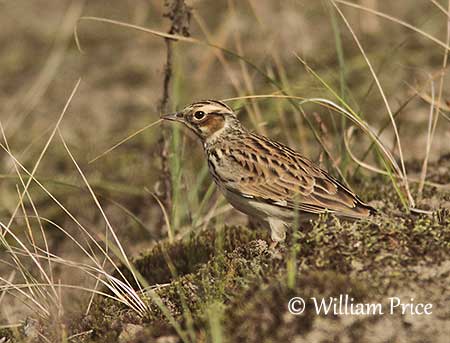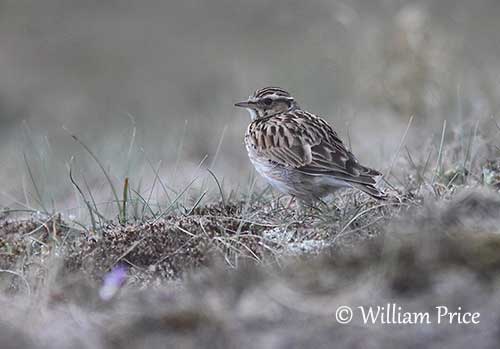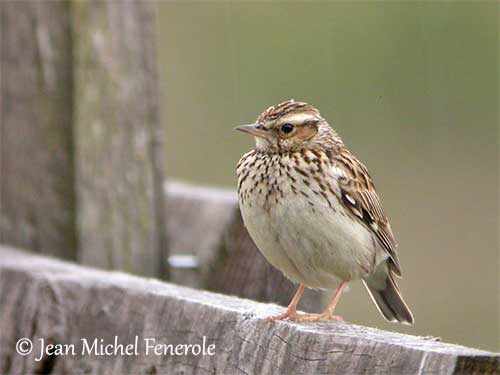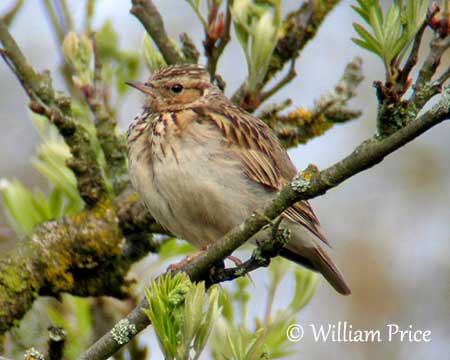
PROTECTION / THREATS / STATUS:
The Woodlark is sparsely distributed or local, but it is usually fairly common throughout the wide range.
This species is threatened by habitat loss and some declines are caused by changes and degradation of this habitat, roads and human developments. However, local increases and range expansion have been observed in W Europe. Numbers of breeding birds also increase after mild winters, especially in N, W and C Europe.
A very preliminary estimate of the global population size is 4,150,000/13,200,000 individuals. Further validation of this estimate is required.
The Woodlark is currently evaluated as Least Concern.
Fr: Alouette lulu
Ang: Woodlark
All: Heidelerche
Esp: Alondra Totovía
Ita: Tottavilla
Nd: Boomleeuwerik
Sd: Trädlärka
Photographers:
Jean Michel Fenerole
Photos d’Oiseaux du monde
William Price
PBase-tereksandpiper & Flickr William Price
Jean Marc Rabby
Des Ailes et des Plumes
Ingo Waschkies
My bird pictures on Pbase
Text by Nicole Bouglouan
Sources:
HANDBOOK OF THE BIRDS OF THE WORLD Vol 9 - by Josep del Hoyo - Andrew Elliot - David Christie - Lynx Edicions - ISBN: 8487334695
THE COMPLETE BOOK OF BRITISH BIRDS – Written by “Royal Society for the Protection of Birds” experts - Préface de Magnus Magnusson - Michael Cady- Rob Hume Editors - ISBN: 0749509112
THE HANDBOOK OF BIRD IDENTIFICATION FOR EUROPE AND THE WESTERN PALEARCTIC by Mark Beaman, Steve Madge - C. Helm - ISBN: 0713639601
ENCYCLOPEDIE DES OISEAUX DE FRANCE ET D’EUROPE – de Peter Hayman et Rob Hume - Flammarion – ISBN : 2082009920
BIRDS OF THE MIDDLE EAST by R.F. Porter, S. Christensen, P Schiermacker-Ansen C.Helm - ISBN: 0713670169
Wikipedia, the free encyclopaedia
Woodlark
Lullula arborea
Passeriformes Order – Alaudidae Family
INTRODUCTION:
The Woodlark is well known for its flight and its song. It is very distinctive with its short tail and broad, rounded wings, while performing a deeply undulating flight.
It usually frequents open spaces with scattered trees, forest clearings and young plantations, heathland and mountain slopes up to the tree line. It feeds primarily on plant material, but it also takes insects during the breeding season.
The Woodlark is sparsely distributed but common, with currently stables populations.

DESCRIPTION OF THE BIRD:
Biometrics:
Length: 15 cm
Weight: 25-35 g
The Woodlark adult of nominate race has rufous-brown crown and upperparts with black streaks. The rump is uniformly browner. On the upperwing, the secondary wing-coverts and the tertials are browner with pale tips and edges. The flight-feathers are dark brown. The primary coverts are black with broad white tips, whereas the alula is whitish. The tail has brown central pair, dark brown outer rectrices with pale outer webs, and other rectrices are mostly blackish with broad white tips.
The underparts are whitish with buff tinge on breast and flanks. The breast is streaked black and the flanks show indistinct greyish streaks.
On the head, the rufous-brown crown is streaked black. There is a conspicuous white supercilium meeting to form a V-shape on the nape. The ear-coverts are rufous and bordered with white below. We can see blackish moustachial and malar stripes.
The bill is brown with pinkish lower base. The eyes are dark brown. Legs and feet are pinkish to flesh. The hind toe has a longer claw.
Male and female have similar plumage, but she is smaller than male.
The juvenile show scaly pattern above, and the breast is more spotted than streaked.
SUBSPECIES AND RANGE:
The Woodlark has two recognized subspecies.
L.a. arborea breeds from S Fennoscandia, S Britain, France and N Iberia, E to W Russia, Ukraine, N Italy and N Balkans.
L.a. pallida occurs in S Europe and NW Africa, E to Turkey, Caucasus, Levant (S to N Israel), Iran and SW Turkmenistan.
This race is paler and greyer than nominate, with less buff below.
HABITAT:
The Woodlark usually frequents lowland heath, and mainly areas with short vegetation and scattered tall trees. It also occurs in forestry plantations, young plantations and forest clearings, and can be seen on mountain slopes up to the tree line. These habitats provide it abundant food sources, perches and singing posts and nesting cover.
The Woodlark avoids arid country and intensively cultivated areas. However, during winter, it may frequent more open cultivated fields such as stubble fields.

CALLS AND SONGS: SOUNDS BY XENO-CANTO
The Woodlark’s usual call is a clear, liquid but ringing “titloo-eet” note, given while perched or rising into the air.
The song is a melodic, sweet series of clear, rising and falling trills interspersed with repeated, descending “tliu tliu tliu tliu liuii liuii tiu tiu tiu”. This fluting song is one of the most beautiful among wild species. It can be heard both during the day and at night.
BEHAVIOUR IN THE WILD:
The Woodlark feeds primarily on plant material in summer and outside the breeding season. This diet includes leaves and seeds of grasses and other broadleaf plants.
During the breeding season, it takes mostly invertebrates such as Lepidopteran caterpillars, Coleopterans, Dipterans and spiders.
The Woodlark forages on the ground, taking the food from the lowest parts of plants and from soil surface.

During the breeding season, the male performs a butterfly-like song flight. It climbs in spiral up to 100-150 metres, rising and falling, descends slowly, sometimes with final plummet, to a perch or the ground.
They are monogamous for a single season. They become territorial during this period. They nest on the ground and solitary.
The Woodlark is mostly resident, but some short-distance dispersals in W and S of the range are reported. This species is partially migratory in C Europe, and migratory in N and S Europe.
Most of northern populations winter in SW France. The birds return to Netherlands in late February, mainly April in Germany.
The Woodlark has rather slow flight action with deep, jerky undulations with series of rapid wingbeats interspersed with glides on closed wings.
In flight, the bird shows a short tail and broad, rounded wings, making it different from the Eurasian Skylark.

REPRODUCTION OF THIS SPECIES:
The breeding season takes place between March and July/August.
The Woodlark nests on the ground, in a deep depression hidden among the vegetation, in a tuft of tall grasses or heather. The female adds a lining of leaves, pine needles and moss, and a top layer made with finer grasses. Several scrapes can be started by both mates, but the final nest is built by the female.
She lays 3-5 creamy-white eggs with brown speckles, making them almost invisible on the ground. She incubates alone during 13-15 days. The chicks are fed by both parents at nest. They leave the nest about 11-13 days after hatching, and they fledge at 15-16 days old.
This species usually produces two broods per year. The chicks of the first brood remain in the surroundings during the rearing of the second brood, and all form a family group in autumn.

